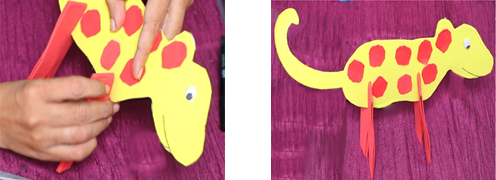
Standing Puppet – Cheetah
 Objective
Objective
To help teachers create a puppet of a cheetah for story-telling and other purposes.
Estimated time to create the standing puppet – Cheetah
1 to 1.5 hours
Materials required for creating the standing puppet – Cheetah
- Yellow chart paper (for the body of cheetah)
- Red foam sheets (for legs)
- Black marker/sketch pen (for drawing facial features)
- Googly eyes (optional, for added effect)
- Glue or adhesive
- Stapler
- Scissors
- Pencil (for drawing the outline)
Preparation for activity
- Ensure all materials are ready and within reach.
- Cut chart paper and foam sheets into manageable sizes.
- Pre-draw the cheetah outline lightly on the yellow chart.
- Prepare a clean, flat surface to work on.
Procedure
- Draw and cut the body of the cheetah
- Sketch a side profile of a cheetah on yellow chart paper or foam sheet (as seen in the first image).
- Cut out the shape neatly using scissors.
- Prepare the legs
- Take red foam sheets and cut them into long strips.
- Fold each strip in half and cut a V shaped slit in the bottom to form the cheetah’s claws/paws. Also make a small slit on the top for inserting the body. Staple the edges and use glue drops for reinforcing the legs.
- Decorate the Body
- Cut small red patches from foam sheet and paste them on the cheetah’s body to represent spots. Attach a googly eye on the face.
- Sketch and cut the tail shape from the yellow foam sheet. Use glue drop to attach the tail to the body.
- Assemble the Puppet
- Draw the mouth and details using a black marker.
- Attach the folded red foam leg pieces to the bottom of the cheetah body to help it stand.
- Make sure the balance is even so the puppet stands steadily.
Step by Step Pictures to create the puppet





Important Tips
- Use bright and contrasting colours for better visual appeal.
- Reinforce the legs with extra foam if the puppet doesn’t stand.
- Add movable joints using brads if you want the puppet to have motion.
- Let glue dry fully before attempting to stand the puppet.
- While creating the puppet, replicate the character illustration given in the children’s textbook. Once the puppet is ready, use the character’s name from the textbook. Using the name in the textbook, helps children to remember the content.
- The teacher should use the puppet at an appropriate time. The teacher can narrate the story in a humorous manner. The teacher may make intentional mistakes to encourage children to correct them, thereby helping them become more actively engaged.
Precautions
- Always keep the face of the puppet towards the audience.
- Avoid using too much glue, as it may make the paper soggy.
Troubleshooting:
- If the puppet doesn’t stand, check if the legs are even and placed symmetrically; reinforce the base with another layer of foam or card.
- If the body bends, use thicker paper or stick another layer to provide strength.
- If the foam strips come off from the legs, use both glue and staples or stronger adhesive for support.
- If the parts are falling off, use stronger glue or secure it with thread stitches.
- If the eyes or small parts are detaching, replace with marker drawings or stitch in place.
 Notes to the Teacher
Notes to the Teacher
- Using puppets also aids in developing motor skills, such as hand-eye coordination. Additionally, puppets can enhance communication and social skills, improve focus and concentration and help teach concepts and values.
- Use this as a fun, hands-on activity to teach about wild animals like the cheetah, their body parts and habitats.
- Integrate it into lessons on storytelling, habitats or animal movement.
- Encourage creativity by allowing students to colour or decorate their cheetahs differently.
Using the Learning Teaching Material
The teacher can conduct a ‘Puppet Show’. Teachers can encourage the students to create these puppets and have a ‘Puppet Show’ in the classroom.
Video: How to use Learning Teaching Material
| Source and Attribution of images All images used in the above Assets and Aids are originally created. |
| This digital material has been developed by the Sri Sathya Sai Vidya Vahini Inclusive Education Project, a unit of Sri Sathya Sai Central Trust, Prasanthi Nilayam, as a collaborative offering in the service of our nation. |